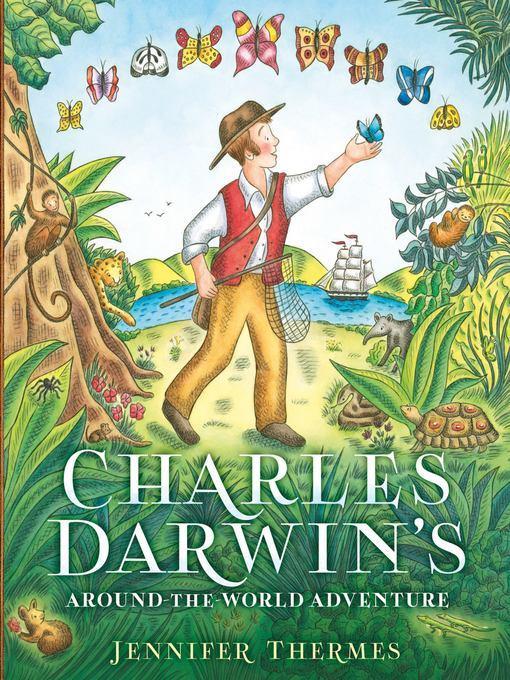
Charles Darwin's Around-the-World Adventure
فرمت کتاب
ebook
تاریخ انتشار
2016
Lexile Score
840
Reading Level
3-5
ATOS
5
Interest Level
K-3(LG)
نویسنده
Jennifer Thermesناشر
ABRAMSشابک
9781613129715
کتاب های مرتبط
- اطلاعات
- نقد و بررسی
- دیدگاه کاربران
نقد و بررسی

August 15, 2016
Letting her background in map illustration shine, Thermes (Little Author in the Big Woods) follows the travels of Charles Darwin while concisely explaining the influence they had on his growing understanding of the interconnectedness of nature. As Darwin sails from England to the South American coast and the Galápagos Islands, Thermes’s neatly outlined pencil-and-watercolor images mix full-bleed scenes of bounteous wildlife with maps of the corresponding landscapes, labeling towns, geographic features, and local animals. A boyish enthusiasm is frequently apparent in Thermes’s portraits of the young scientist at work, even when seasickness was getting the best of him (“The landscape was so different from anything Charles had known in England,” she writes. “He was giddy”). Substantial back matter includes an in-depth look at Darwin’s later life and research, as well as a spread of 18 additional facts tied to his journey. Ages 5–7. Agent: Marietta Zacker, Gallt & Zacker Literary.

July 15, 2016
This introduction to Darwin focuses on his five-year exploratory journey on the HMS Beagle. Young Charles loves searching for insects, birds, rocks, and bones, and he also loves sorting his treasures. After finishing school at Cambridge, he's recommended by his botany professor as naturalist for the Beagle's mapmaking mission around South America. Collecting specimens and recording "big observations about the tiniest of creatures" in his journal, Charles often remains behind to explore while the Beagle sails the coastline. The forthright narrative highlights Charles' coming-of-age as a young man and scientist. In Tierra del Fuego, he observes the food chain: "The bigger animals couldn't survive without eating the smaller ones. Charles saw how their lives were all connected." Exploring the Andes, Charles' speculations about the effects of volcanic eruptions, earthquakes, and tsunamis are proven when he finds seashells embedded in high-elevation rocks. Thermes' pencil-and-watercolor maps and illustrations are charming, accessible, and idealized. Charles resembles a boy throughout, save for his long sideburns. Some spreads group many species together in tableaux designed for browsing rather than scientific exactitude. The famous Galapagos Islands stopover gets special attention, and a cross section of the departing Beagle shows tortoises--for eating--in the hold. Endpapers map the global journey and include a timeline, some of which is hidden behind the front flap. A notable choice for both STEM curricula and family sharing. (notes, sources, further reading, "fun facts") (Informational picture book. 5-8)
COPYRIGHT(2016) Kirkus Reviews, ALL RIGHTS RESERVED.

October 1, 2016
K-Gr 3-Thermes traces the route of the 1831 voyage of the HMS Beagle in this picture book biography of Charles Darwin. The focus of the story is on Darwin's wonder and delight as he observed and collected animals, plants, stones, and fossils on his five-year journey around the world. The endpapers feature maps of the departure and return (details of which will be obscured by the book jacket covers used in many libraries). Friendly watercolor and pencil illustrations portray the creatures and objects that fascinated Darwin. However, the art does not always line up with the text. In one spread, a tiny Darwin is highlighted on the deck of the HMS Beagle, yet a page turn shows him under a tree in the rain forest. (A few pages later, we learn that he was seasick and "happy to stay on land and explore.") In another spread, a dramatic moment in which his small boat is almost capsized by a calving glacier is paired with a map of the crew's route around Tierra del Fuego. Young readers unfamiliar with the naturalist's work may be puzzled by the ending: "And what he wrote would change the world forever." Back matter has a brief explanation of evolution. VERDICT An additional purchase for elementary school science collections.-Jennifer Costa, Cambridge Public Library, MA
Copyright 2016 School Library Journal, LLC Used with permission.

October 15, 2016
Grades 1-3 This large-format book first introduces Darwin as a boy collecting bugs, but quickly moves on to the main subject: his voyage aboard the Beagle. The ship's many stops, particularly in South America and the Galapagos Islands, gave the young naturalist opportunities to observe wildlife, collect specimens, and muse about topics such as how fossils of sea creatures came to be embedded in rocks far above the ocean. Though the narrative ends when he returns home, the appended notes continue his story. The large-scale watercolor-and-pencil illustrations portray Darwin as a boyish figure in a colorful world teeming with life. Throughout the book, the most visually impressive features are Thermes' many excellent maps. Similarly, the endpapers display two world maps that are informative as well as decorative. Each indicates the locations Darwin visited with red dots and the Beagle's route with directional arrows, while providing a more detailed listing of locales below. The first map shows the outbound voyage, and the final one, the return trip. A colorful, childlike presentation of Darwin's eye-opening voyage of discovery.(Reprinted with permission of Booklist, copyright 2016, American Library Association.)

























دیدگاه کاربران